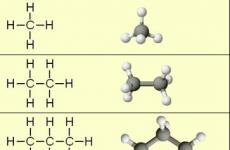Climatic zones Description. Climatic zones
People often consider unfamiliar environment as an enemy and consider what should fight her. This is not a way you live - if you fight with an ok-rushing medium, then lose! There are certain dangers that require relevant precautionary measures, but nature is not aggressor. Learn to live in harmony with any climate and use what he can give. The climate is determined not only by geographic latitude; The location of the mainland and the height is no less important.
Polar zone
The polar districts include those that are located in latitudes more than 60 ° 33 ', both north and south, but the ability to exist at low temperatures may be required anywhere else on the pain of heights. For example, next to the Equator in Andes, the lower boundary of eternal snow is located at an altitude of 5000 m, but the closer to the southern pole, the same border is lowered, - and on the lower tip of South America, eternal snow lie at the height of several hundred meters (about three hundred). In turn, the Arctic conditions extend deep into the northern territory of Alaska, Canada, Greenland, Iceland, the Scandinavian Peninsula and Russia.
Tundra
This is the southern part of the polar cap, where the land has a layer of permafrost, and the vegetation is low. In summer, the snow melts, but Cor-neither can penetrate the solid ground. Big heights create similar conditions.
Northern coniferous (boreal) forests
The arctic tundra and lands with a temperate continental climate lies the forest zone, the average width of which is about 1.300 km.
In Russia, where it is called Taiga, the forests stretch 1650 km and more, Mes-Tami entering the northern polar circle along the Siberian rivers. In Canada, in Rayo-Ned Hudson Gulf, the upper boundary of the growth of forests passes south of the polar circle.
Winter are long and harsh, earth almost all the time frozen, summer is short. The soil is sufficiently soft, in order for water to pass to the roots of plants, only 3-5 months a year. Vegetation is especially magnificent along the rivers current in the Arctic Ocean. Many game: Elk, Bear, Otter, Lynx, Sable and Protein, as well as smaller animals and birds.
In the summer, where melt water can not go to the ground, the swamps are formed. Falling trees and thick pigs MKA make it difficult to move. Mosquitoes and midges create problems (but are not carriers of malaria).
In winter, moving easier if there are warm clothes. Go along the rivers, where the fish is well caught, making the raft from the fallen trees available in the abundance.
Zone of moderate climate
Zone moderate climate The northern hemisphere and a similar zone in the southern in Lushary provide probably the most favorable conditions for survival without special skills, skills or knowledge. These places will be most familiar with most readers of this book. It is also the most urbanized territories, and here the rescue process is unlikely to strongly delay. A healthy and prepared person with basic skills will not be so isolated so as not to get help for several days. Winter conditions may require knowledge of life support in polar conditions.
Deficial (broadly) forest
As the climate becomes softer and winter becomes warmer, the coniferous forests are shifted. In America, the main deciduous rocks are oak, beech, maple and karya, or hickory; In Eurasia, this is oak, beech, chestnut and linden. On rich humus, many rashes and mushrooms grow well. It is not difficult to survive here, with the exception of very large heights, where conditions are similar to the tundra or snowy expanses. Many of these places are well known to humans.
Prairie, steppe
Areas that are mainly in the central parts of the continents, with hot summer, cold winter and a moderate amount of precipitation became the main regions of the world that produce food - here the grain is expressing and bred. In the summer, the problem may be water, and in the winter - the UK-Ryet.
Mediterranean zone
The lands bordering the Mediterranean Sea belong to the half-possession zones where summer is long and roast, and the winter is short and dry. There the sun shines almost round year And blow dry winds. Once there were many oaks in this region. When they were cut down, the erosion of the soil occurred, and the earth was covered with evergreen shrubs. California Chaparal is a very similar place. There are few trees, with water great difficulties. Other conditions prevail at high altitudes.
Rainforests
The land underlying between the tropics includes both cultivated land, and the extremes of the swamps and deserts. However, one third of this zone is the bottom of Wild forests: Equatorial rainforest (jungle), wet sub-tropical forest and mountain forest. Everywhere a large number of precipitation and mountains, water from which flows into big fast riversAnd coastal and other low-lying areas are often wetched.
Savannah
This is a tropical steppe, or a prairie, located usually between the zones of Pus-Tyn and Tropical Forests. Near the forest area is high, up to 3 meters, and Dere-Vya is more common. Temperatures are high all year round. More than a third of Africa occupy savannahs, they are busy large squares Australia in which eucalyptus grow. Similar places are Llanos Plains in Venezuela and Column Bii, as well as Campos in Brazil. Often water is missing, but where it is, lush vegetation and rich animal world. In Africa, you can find large flocks of animals.
Desert
One fifth Sushi surface is busy with deserts - dry fruitless lands, where it is very difficult to survive. The deserts are formed there, where the air flows, which begin at the equator and have already gave their moisture, go down to the surface and again heated as they approach it, taking those crumbs of Vu-gi, who still remained. There almost no clouds protecting direct sun ray And keeping warm near the ground at night, therefore there are huge temperature differences: from very high temperatures in the afternoon in the shade (58 ° C in sugar) to a minus night. Only a small portion of these zones is over-the sandy deserts (at the same time one tenth is represented by Sakha-Roy), the main part of the desert is the plains covered with gravel and excised Super-Chelv River Rivers (Wadi). The wind blew the sand, collecting him in lowlands. In other Mes-Tah, it can be weathered mountains, frozen mud and lava flows.
When studying the vegetation cover of the Earth, it can be noted that there is division into zones in which certain representatives of the flora prevail. The same statement applies to the animal world. This is determined by the special climate conditions existing in each specific area. Based on these observations, divide on climatic zones. Consider them in more detail.
The equatorial zone, or inner tropical, includes a part of the sushi, which extends along the equator to the beginning of 10 ° YU. sh. and 10 ° С. sh. This zone is characterized by plenty of precipitation and high air temperature. Temperature oscillations are minor.
Then follows the external tropical zone. It is also characteristic heatBut precipitation falls significantly less. Rainy periods are replaced by dry. All climatic zones have their own characteristics Weather conditions.
Next comes the zone of subtropics or zone of trade winds. Here, the amount of precipitation is significantly reduced. The air in this zone is less wet. Because of the rising air flows, the weather is cloudless, and the fluctuations in the air temperature during the day are minor. Desert predominates in this climatic zone.
The ethesy zone is characterized by a sharp replacement of the rainy winter in summer with dry weather.
The zone of moderate climate is distinguished by a large amount of precipitation during the year. The climate in such areas may be warm, almost without frost or cold, but short winters. It depends on the proximity of the ocean.
But this is not all climatic zones presented on our planet.
The next is a zone of moderate latitudes for it is characterized by a small amount of precipitation, the minimum cold winter and warm summer.
Climatic zones Earth completes the last, polar or arctic zone. It is distinguished by small precipitation and very low temperature air.
The climatic signs of the following zones are pronounced: Tundrov, Forest, Festourprove, Steppe, Summer and Arctic.
Climatic zones affect the country's economy. They define I. vegetable world. For example, Russia is the largest earlier and supplier of valuable furs.
Thus, the climatic zone is a sign of one or another territory of the planet. It becomes a determining factor for the habitat of animals and growing certain types of plants. Each climatic zone corresponds to its climate, which depends on air and marine currents.
The climate is the result of the interaction of many natural factors, the main of which is the arrival and consumption of the radiant energy of the Sun, atmospheric circulation, redistributing heat and moisture, and moisture turnover, almost inseparable from atmospheric circulation. Atmospheric circulation and moisture, generated by heat distribution on Earth, in turn affect the thermal conditions of the globe, and therefore, and on everything that is directly controlled by directly or indirectly. Causes and consequences are intertwined here so closely that all three factors should be considered as complex unity.
Each of the listed factors depends on geographic location Terrain (latitude, heights above sea level) and the nature of the earth's surface. The latitude determines the size of the inflow of solar radiation. The temperature and pressure of the air, the content of moisture in it is changed, the conditions of wind conditions in it. Features of the earth's surface (ocean, land, warm and cold sea currents, vegetable, soil, snow and ice cover, etc.) strongly affect the radiation balance and, therefore, on the circulation of the atmosphere and moisture proof. In particular, two main types of climate: sea and continental are formed under the powerful transformative influence of the underlying surface.
Since all climatic formation factors, in addition to the relief and location of the sushi and the sea, tend to zonality, it is quite natural that climates are zonal.
B.P. Alice subdivides the globe on the following climatic zones (Fig. 4):
1. Equatorial zone. Weak winds prevail. Differences in temperature and humidity between the days of the year are very small and less daily. Average monthly temperatures from 25 to 28 °. Precipitation - 1000-3000 mm. It is dominated by hot wet weather with frequent shines and thunderstorms.
Sub-screen zones. It is characterized by a seasonal change of air masses: in the summer, the monsoon blows on the part of the equator, in the winter - on the side of the tropics. Winter is just a little cooler summer. With the domination of the summer monsoon, it is about the same weather as in the Equatorial zone. Inside the continent of precipitation rarely more than 1000-1500 mm, but on the slopes facing monsoon, the amount of precipitation reaches 6000-10,000 mm per year. Almost all of them fall out in the summer. Winter dry, daily amplitude of temperature compared to the equatorial zone increases, the weather is cloudless.
Tropical zones of both hemispheres. The predominance of trade winds. The weather is predominantly clear. Winter warm, but noticeably colder summer. In tropical zones you can allocate three types of climate: a) the areas of sustainable trade winds with cool, almost dishefit weather, high humidity, with developed on the coasts of fogs and strong breezes (West Coast of South America between 5 and 20 ° C. sh., Sahara coast, Namib desert); b) trade-stone areas with passing rains (Central America, West India, Madagascar, etc.); c) Roast arid areas (sugar, Kalahari, most of Australia, North Argentina, Southern Half of the Arabian Peninsula).
Subtropical zones. A distinct seasonal course of temperature, precipitation and winds. Perhaps, but very rarely dropping snow. With the exception of monsoon areas, anticyclonic weather predominates, in winter - cyclonic activity. Types of climates: a) Mediterranean with clear and quiet summer and rainy winter (Mediterranean, average Chile, Capskaya Earth, South-West Australia, California); b) monsoon areas with hot rainy summer and relatively cold and dry winter (Florida, Uruguay, North China); c) dry areas with hot summer (South Coast of Australia, Turkmenistan, Iran, Takla Maka, Mexico, Dry West USA); d) evenly moisturized during the year of the region (southeast of Australia, Tasmania, New Zealand, middle part of Argentina).
Moderate climate zones. Over the oceans in all seasons - cyclonic activity. Frequent precipitation. The predominance of Western winds. Strong temperature differences between the winter and summer and between the land and sea. In winter, snow drops. The main types of climates: a) Winter with unstable weather and strong winds, in summer, the weather is more relaxed (United Kingdom, Norwegian coast, Aleuta Islands, Alaska Bay coast); b) different variants mainland climate ( interior USA, South and South-East of the European part of Russia, Siberia, Kazakhstan, Mongolia); c) transitional from the mainland to the oceanic (Patagonia, most of Europe and the European part of Russia, Iceland); d) monsoon areas ( Far East, Okhotsk coast, Sakhalin, North of Japan); e) areas with wet cool summer and cold snowy winter (Labrador, Kamchatka).
Subolar zones.Large temperature differences between winter and summer. Eternal Frost.
Polar zones. Large annual and small daily fluctuations in temperature. Precipitation little. Summer cold and foggy. Types of climates: a) with relatively warm winter (sea coast Beaufort, Buffhin Earth, Northern Earth, New Earth, Spitsbergen, Taimyr, Yamal, Antarctic Peninsula); b) with a cold winter (Canadian archipelago, Novosibirsk Islands, the coast of the Seas of EastNesibirsk and Laptev); c) with a very cold winter and summer temperature below 0 ° (Greenland, Antarctica).






